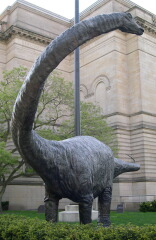Facts About Dippy
Dippy, the renowned Diplodocus skeleton, stands as a premier attraction at the Carnegie Museum of Natural History in Pittsburgh. Officially designated as Diplodocus carnegii, this skeleton has achieved global fame, largely due to Andrew Carnegie's generous donations of plaster casts to major museums worldwide in the early 20th century. These casts not only popularized Dippy but also the term "dinosaur."
The story of Dippy began in Wyoming in 1899, following an initial excavation announcement in 1898. John Bell Hatcher played a crucial role in unearthing and naming the species Diplodocus carnegii. The assembled skeleton is a composite, incorporating various parts including most of the vertebrae, the tail, sections of the skull, and even some bones from a Camarasaurus.
Since 1907, the original Dippy skeleton has been proudly displayed in Pittsburgh as a centerpiece of the museum's "Dinosaurs in Their Time" exhibition. Andrew Carnegie's financial support for the acquisition and casting of Dippy catapulted it to international acclaim. One of the most notable casts was donated to the British Museum in London, where it remained an iconic exhibit until it was replaced by a blue whale skeleton in 2017.
However, Dippy's legacy did not end there. Since 2018, the casts have been touring various British museums, continuing to captivate audiences. To commemorate the 100th anniversary of Dippy's discovery, a life-size fiberglass sculpture was unveiled in Pittsburgh in 1999. This sculpture has since become a cherished mascot for the museum and a landmark in Pittsburgh. It is often adorned with local sports gear and university colors, adding a touch of community pride to this prehistoric marvel.

 Mexico
Mexico